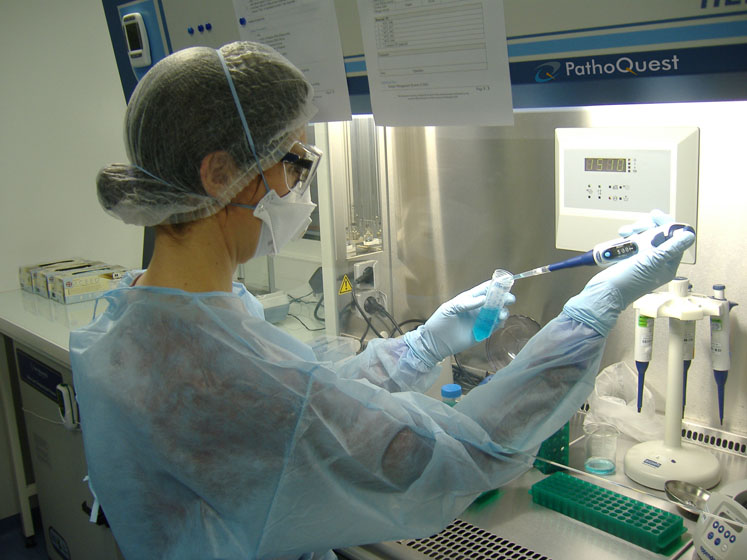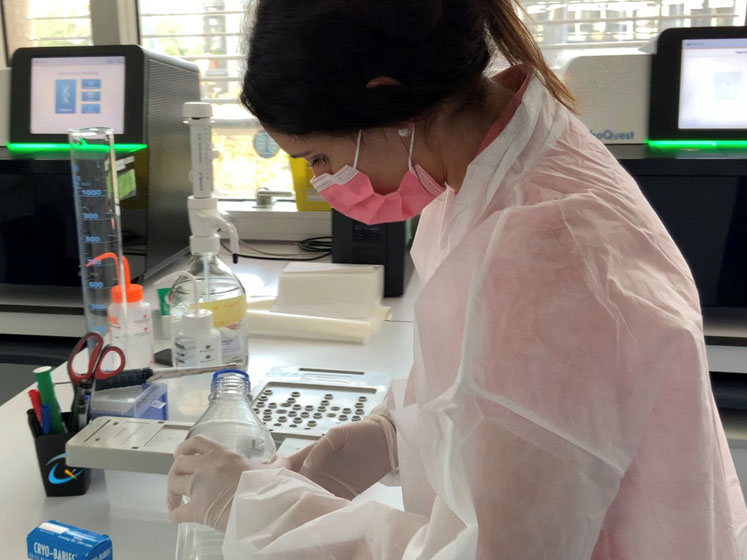Biologics are a fast-growing trend that has overtaken chemical drugs as the next wave of revolutionary new therapeutics. However, their biomanufacturing brings new needs and new risks to the process. As biologics become more and more sophisticated, traditional testing methods to ensure their biosafety, such as in vitro and in vivo testing, have quickly become outdated.
Meanwhile, technologies such as next-generation sequencing (NGS) have grown in popularity, helping to advance the safety of breakthrough therapies that require fast turnaround times, such as cell and gene therapies. In doing so, NGS-based biosafety testing has given the biologics and bioproduction ecosystem a much-needed facelift.
The inevitable shift from chemical drugs to biologics
Estimated to be worth €240 million in 2019, the market share of biologics continues to be fast-growing.1 Not surprisingly, then, new risks brought by the advent of those biologics have emerged, most notably the risk of viral contamination during the bioproduction process from raw material to batch release.
The industry became aware of those risks the hard way. Cases of vaccine contamination in the mid-1900s revealed that the likelihood of viral contamination was quite real, with oversight by the US FDA and other agencies emerging shortly thereafter.2
Consequently, the International Council for Harmonization’s (ICH’s) Q5A guideline for biotechnological products was adopted in 1997.3 Since then, the risk of viral contamination in bioproduction batches has dropped significantly, with testing strategies such as in vitro and in vivo testing, as well as targeted polymerase chain reaction (PCR) assays further mitigating the risk.
However, even with the advent of sophisticated biologics such as cell and gene therapies, the risk of viral contamination remains.4 Cell therapies, by their very nature, bring about specific challenges. One of the most significant risks lies with the source itself, as well as the quality and/or purity of the available starting raw materials.

Any of these components can become contaminated at any point during their manufacture or use. Interestingly, the past decade has witnessed a growing gap between the speed at which innovative biotherapeutic products have emerged and the speed at which the prevention and detection of adventitious agent contamination have evolved.4
It became clear that methods to assess the presence or absence of viral contaminants during the biomanufacturing process needed to be revamped to more effectively prevent and control these new risks.
Today, the real challenge is how to best develop and apply quality control tools that not only meet the current level of sophistication of these novel and innovative therapies … but also maintain compliance with extant guidelines, fit into the 3Rs model of reducing, replacing and refining animal testing and, at the same time, reduce the cost and accelerate the timelines of product release.
Quality control left behind
Although the use of personalised therapies using biologics has grown considerably in recent years, quality control practices have not kept pace.5 As a result, there is a disconnect between biotherapies and the regulations surrounding quality control. The biosafety testing industry as we know it continues to be driven by the same collection of guidance documents that have remained untouched for decades (such as ICH Q2A [R1]).6
In vitro and in vivo biosafety tests are still the workhorses of the industry, but those methods show drawbacks as they are indirect assessments of safety.3 Indeed, they enable the detection of infection, but cannot identify the offending agent itself.
Cell lines and animal models have variable sensitivity to viruses that can lead to false negatives. Moreover, in vitro and in vivo testing approaches are considered to be cumbersome, time-consuming and hypothesis-driven. This means only certain viruses, to which the system is susceptible, are sought.7
The guidelines currently in place were established some 20 years ago at a time when NGS was not yet used for industrial applications. Thus, the regulatory guidelines did not consider its advantages at the time.
Fortunately, the guidance documents focused on ensuring safety while leaving the door open to the nature of the testing strategy, including any relevant state-of-the-art technologies.8 This allowed breakthrough technologies such as NGS to have a positive impact throughout the entire biologics industry.
NGS has moved well beyond targeted applications, revealing a more global view by its very agnostic nature. As a fresh reminder, this approach seems even more relevant today during the COVID-19 pandemic — as an average of 400 new viruses appear every year.9
Unlike more traditional biosafety tests, NGS enables direct detection, at the genome or transcriptome level, and identification of the agent of concern Further, transcriptomic NGS-based protocols that target the messenger RNA of the virus can show evidence of virus replication and can thus distinguish infectious viruses from carryover sequences.10
Another advantage of NGS has been highlighted by recent regulatory changes that are driving the reduction of animal use in viral safety tests, such as those done on adult mice, suckling mice, hamsters and embryonated eggs. To comply with the three Rs principle of animal experimentation, the regulatory bodies are indeed pushing to limit the use of animal models only when there are no other alternatives.
Developed in 1959, the three Rs represent the ethical approach applied to animal experimentation in Europe and North America, which recommends
- reducing number of animals in experiments
- refining the methodologies used
- replacing animal models.11
More recently, in September 2021, the European Medicines Agency (EMA) published new measures to limit animal testing in the context of drug development. As such, NGS-based testing stands as an ethical alternative to in vivo testing. Interestingly, PathoQuest and Charles River Laboratories have demonstrated the superiority of an NGS-based method compared with animal testing in a joint study, shared at the June 2021 Parenteral Drug Association’s Conference, directly comparing both approaches.
Closing the gap and unleashing breakthrough therapies
Pharmaceutical and biotech companies producing vaccines and advanced therapy medicinal products (ATMPs) have been early adopters of NGS-based viral safety testing solutions and are driving the market today. One of the biggest struggles for both the industry and agencies worldwide has been understanding when and how to best apply this technology without introducing any new or undue risks.
The challenge lies in understanding how NGS fundamentally differs from traditional tests and where the advantages are. Historically, technologies such as NGS were often relegated to early or upstream product development, settling comfortably in the research and development space owing to its perceived novelty, the fear of discovering something unknown and/or the inherently higher cost for applications.
In reality, in its quiet decades-long history, it has been used for a wide range of applications in both the clinical and biopharma space.
For instance, the French biotech company Transgene, which is developing an individualised therapeutic vaccine to treat cancer, noted that NGS was the most relevant and rapid approach to assess their raw materials and biological products for viral contaminants.
Transgene’s manufacturing process, involving the engineering and delivery of a modified viral vector to the patient, leverages NGS to ensure compliance of the end product as part of an advanced quality control process. For its personalised vaccine, currently in Phase I, Transgene has submitted various registration files to the French, British and American health agencies, with the use of NGS approved by all three authorities.

The acceptance of NGS by health authorities in this instance is a strong sign of the impact of NGS in the biosafety testing arena. Before NGS, it would have taken several months to release a vaccine batch. Today, with NGS, only 2–3 weeks are needed from results to release. Although the authorities are still cautious about new technologies, recent approvals of these registration dossiers have shown the strength and application of NGS in action.
NGS is clearly driving a shift away from old perceptions. Like PCR of 20 years ago, NGS has taken decades to establish itself as a game-changing tool in the biosafety testing toolbox and regulatory authorities have finally started to embrace the power that is NGS.
This is most evident in the European guidelines wherein there has been a concerted effort to update several documents, including ICH Q5A, to include NGS as an alternative to traditional animal- (in vivo) and cell-based (in vitro) testing for the detection of adventitious viruses.3
The updated version should be released by the end of 2022. The positive impact of this throughout the biopharma industry is significant given the clear advantages of NGS compared with classic testing strategies. But, more importantly, it’s opening new possibilities for innovative biologics and breakthrough therapies.
References
- www.researchandmarkets.com/reports/5143069/global-biologic-therapeutics-market-2021-2025.
- https://pubmed.ncbi.nlm.nih.gov/20375174/.
- www.ema.europa.eu/en/ich-q5a-r1-quality-biotechnological-products-viral-safety-evaluation-biotechnology-products-derived.
- www.nature.com/articles/s41587-020-0507-2.
- https://bioprocessintl.com/manufacturing/single-%20use/embracing-innovation-in-bioprocessing-and-biomanufacturing/.
- www.ema.europa.eu/en/ich-q2-r1-validation-analytical-procedures-text-methodology#current-effective-version-section.
- https://pubmed.ncbi.nlm.nih.gov/24681273/.
- https://www.fda.gov/media/71394/download.
- https://elifesciences.org/articles/51971 and www.ncbi.nlm.nih.gov/genbank/.
- www.criver.com/eureka/emergence-next-gen-sequencing-analyzing-biologics-0.
- https://ec.europa.eu/environment/chemicals/lab_animals/legislation_en.htm.




